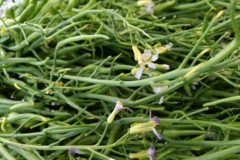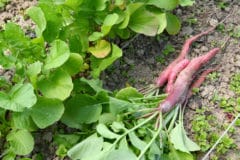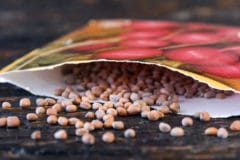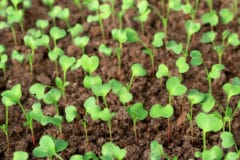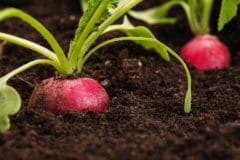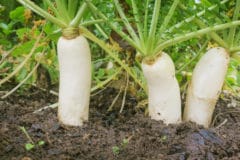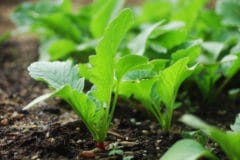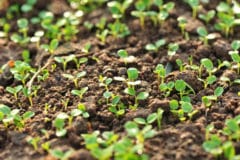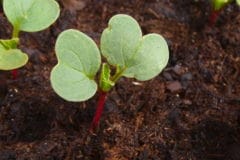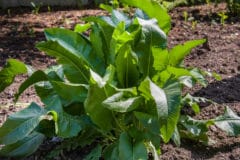More Than Meets the Eye
Radishes are grown all over the world. Most people would instantly recognize what they think of as a radish – round, red and sharp-tasting. But radishes also come in fuchsia, pink, purple, white and green. They can be one-inch globes, carrot-shaped and from six to 18 inches long, or 100-pound monsters. Then there are the edible podded or rat-tailed radish, and the soil-improving oilseed radish.
Variety, Thy Name is Radish
The most commonly recognized radish varieties are also called spring radishes. They include:
- Cherry Belle – 22 days; cherry red with crisp white fles
- French Breakfast – 25 days; scarlet with white base
- White Icicle – 27 days; like a small white carrot with a slightly pungent taste
- Easter Egg – 30 days; although all the same variety, radishes can be pink, purple, white, red or ringed.
Unusual Radishes
In addition to spring radishes, you can grow:
- Rat-tailed Radish – 60 days; grown for their spicy seed pods, these tolerate summer heat and can be harvested over a long period
- Oilseed Radish – maturity dates vary; a variety of daikon radish, these are used in the US for soil improvement and animal fodder
- Sakurajima Mammoth – up to six months; the largest radish known, it can weigh 100 pounds.
Soil for Radishes
Most radishes – oilseed radishes are an exception – prefer light, sandy friable soil with lots of humus. The soil should be water-retentive but also drain well. The smaller globe radishes don’t need very deep soil; eight to 12 inches is plenty. Daikons, however, can grown 18 inches long and need a deep bed. The Sakurajima Mammoth needs at least two feet for best size.
Soil Improvement
Oilseed radishes (a type of daikon radish) have long been used for soil improvement. Farmers in the US often plant them for this purpose and allow livestock to graze them as well. Their long roots bore deep holes and can break up hardpan. Harvest roots and leaves, and shred for the compost pile. The roots and leaves contain minerals that will enrich the compost as they break down.
Nutrients for Radishes
Like most root crops, radishes need a good supply of phosphorus in the soil. However, too much nitrogen causes leafy growth at the expense of the roots. Organic fertilizers like compost, well-rotted leaf mulch and aged manure are good soil amendments. Rock potash and bone meal help provide important minerals. A pH of 6.5 to 7 promotes nutrient absorption.
Radish Season
Radishes are a cool-weather plant. They are so cold hardy they can be sown four to six weeks before the last expected frost. Long season varieties can winter over in many climates. Sow radishes in late August or early September for a fall crop. Only edible podded radishes do well in summer. No matter what the season, it’s best to plant small crops every two or three weeks.
Germination
Radish seeds germinate quickly; some of the short varieties may germinate in two or three days. In very cool weather, germination may take 10 to 14 days. Ideally, the air temperature should be between 50 and 65 °F (10 and 18°C). Ideal soil temperature ranges from 45 to 85 °F (7 to 29°C). It’s very difficult to germinate radish seeds when soil temperature is above 95 °F (35°C).
Watering Radishes
Like Goldilocks, radishes need the soil moisture to be “just right.” Too much water can cause rot in seedlings, and excessively wet soil may also rot developing roots. Dry soil delays or even stops germination and can cause splitting in developing roots. Give radishes a minimum of one inch of water per week; keep the soil evenly moist at all times.
How to Space Radishes
Spring radishes don’t need much space; an inch between plants is usually plenty. Radishes with longer maturity periods tend to be larger and may need an inch-and-a-half between plants. Daikons are stockier and should be planted on six-inch spacing. Edible podded radishes need 18 inches between plants. The Sakurajima Mammoth needs lots of space as it may reach more than two feet in diameter.
Thinning Radishes
Radishes should be thinned to the proper spacing. If you have any concerns about old seed or poor germination, it’s better to sow thickly and then thin after they germinate. Clip the sprouts off at ground level with a pair of sharp scissors to avoid root damage. Once they’re thinned, edible podded radishes should be staked, as they can grow several feet tall.
Pests and Diseases
Radishes are not generally bothered by insects in the home garden. Leafhoppers, root maggots and flea beetles may chew on either leaves or roots. Floating row covers may help deter these pests. The roots may still be OK to eat even if leaves are damaged. Aphids may also attack radishes; lady bird beetles (lady bugs) are often helpful as controls.
Radish Problems
The main problems you’ll find with radishes are splitting, toughness and excessive heat. Too much or two little water increases the chance of splitting. Tough radishes are usually overly mature. Radish heat can be related to insufficient water or to growing in high temperatures. Grow your radishes quickly, keep moist but not wet and harvest promptly for best results.
Container Growing
Radishes are a natural for container growing. The small globes of spring radishes need only about six inches of soil. Make sure the containers have excellent drainage. Put in fresh soil and soil amendments for each planting to ensure proper nutrients. You can extend the season by moving containers around the yard or even bring them in the garage for excessively cold weather.
Harvesting
When harvesting radishes, the key is not to let them go too long. It’s best to start sampling about three days before the published maturity date. Smaller radishes can simply be pulled from the ground (make sure the soil is moist). Edible podded radish seed pods are clipped from the stems. Large radishes like the Sakurajima Mammoth must be dug out of the ground.
Storing Radishes
Fresh radishes are best stored in the refrigerator. Cut off tops and root tips, wash well and place in a plastic bag with a moist paper towel in the bottom. They should be good for two weeks. Radishes can also be stored in moist sand in a root cellar. They need high humidity – 90-95 percent. Winter radishes can be stored right in the ground where they were grown.
How to Use Radishes
Although the classic way to use radishes is raw, they can also be cooked. Raw radishes are good in salads or as crudites with a dip. Like most root vegetables, they sweeten when roasted with a little olive oil. Older radishes that are beginning to soften can be braised with a little cream or butter and fresh chopped garlic added at the last minute. In the Orient, radishes are also pickled.

